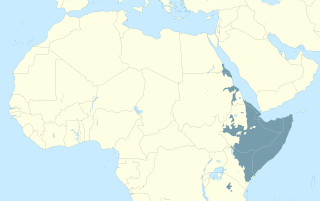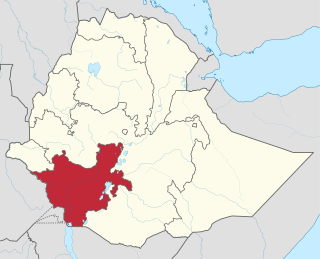Related Research Articles

The Cushitic languages are a branch of the Afroasiatic language family. They are spoken primarily in the Horn of Africa, with minorities speaking Cushitic languages to the north in Egypt and Sudan, and to the south in Kenya and Tanzania. As of 2012, the Cushitic languages with over one million speakers were Oromo, Somali, Beja, Afar, Hadiyya, Kambaata, and Sidama.
Amharic is an Ethiopian Semitic language, which is a subgrouping within the Semitic branch of the Afroasiatic languages. It is spoken as a first language by the Amharas, and also serves as a lingua franca for all other populations residing in major cities and towns in Ethiopia.
Ongota is a moribund language of southwest Ethiopia. UNESCO reported in 2012 that out of a total ethnic population of 115, only 12 elderly native speakers remained, the rest of their small village on the west bank of the Weito River having adopted the Tsamai language instead. The default word order is subject–object–verb. The classification of the language is obscure.

The Southern Nations, Nationalities, and Peoples' Region was a regional state in southwestern Ethiopia. It was formed from the merger of five kililoch, called Regions 7 to 11, following the regional council elections on 21 June 1992. Its government was based in Hawassa.
Lowland East Cushitic is a group of roughly two dozen diverse languages of the Cushitic branch of the Afro-Asiatic family. Its largest representatives are Oromo and Somali.

The languages of Ethiopia include the official languages of Ethiopia, its national and regional languages, and a large number of minority languages, as well as foreign languages.

South Omo Zone is a zone in the Ethiopian South Ethiopia Regional State. South Omo is bordered to the south by Kenya, to the west by West Omo Zone, to the northwest by Keffa Zone, to the north by Ari Zone and Gofa Zone, to the northeast by Gardula, Ale Zone and Konso and to the east by the Oromia Region. The administrative center of South Omo is Dimeka.
Zulgo-Gemzek is an Afro-Asiatic language spoken in northern Cameroon. Dialects are Gemzek, Mineo, and Zulgo (Zəlgwa). Blench (2006) considers Zəlgwa-Minew and Gemzek to be distinct languages.
The Tsamai people are an ethnic group of southwestern Ethiopia. They speak a Cushitic language called Tsamai, which is one of the Dullay languages, and thus related to the Bussa and Gawwada languages.
Tsamai may refer to:
Alagwa (Alaagwa’isa) is a Cushitic language spoken in Tanzania in the Dodoma region. Some Alagwa have shifted to other languages such as Sandawe.
Muyang is an Afro-Asiatic language spoken in and near the town of Tokombéré in the department of Mayo-Sava in northern Cameroon.
Vame or Pelasla is an Afroasiatic language spoken in northern Cameroon.
The Dullay languages belong to the Cushitic subgroup of the Afro-Asiatic language family and are spoken in Ethiopia. Dullay is a dialect continuum consisting of the Gawwada and Tsamai languages. Blench (2006) places most of Bussa in the Konsoid languages, and counts several Gawwada varieties as distinct languages.
Dizin is an Omotic language of the Afro-Asiatic language family spoken by the Dizi people, primarily in the Maji woreda of the Southern Nations, Nationalities and Peoples Region, located in southwestern Ethiopia. The 2007 census listed 33,927 speakers. A population of 17,583 was identified as monolinguals in 1994.
Alphacrambus cristatus is a species of moth in the family Crambidae in the genus Alphacrambus. It was described by Graziano Bassi in 1995 and is known from Ethiopia.
A number of Ethiopian sign languages have been used in various Ethiopian schools for the deaf since 1971, and at the primary level since 1956. Ethiopian Sign Language, presumably a national standard, is used in primary, secondary, and—at Addis Ababa University—tertiary education, and on national television. The Ethiopian Deaf Community uses the language as a marker of identity.
Hamer Bena was one of the 77 woredas in the Southern Nations, Nationalities, and Peoples' Region of Ethiopia. Part of the Debub Omo Zone, Hamer Bena was bordered on the south by Kenya, on the southwest by Kuraz, on the northwest by the Usno River which separates it from Selamago, on the north by Bako Gazer, on the northeast by the Konso special woreda, and on the east by the Oromia Region; the Weito River separated it from Konso and the Oromia Region and the Neri River defined part of the boundary with Bako Gazer. Hamer Bena included part of Lake Chew Bahir along its southeastern border. The administrative center was Dimeka; other towns in Hamer Bena included Arbore, Key Afer, and Turmi. Hamer Bena was separated for Hamer and Bena Tsemay woredas.

Bena Tsemay is one of the woredas in the South Ethiopia Regional State. It is named after Banna and Tsamai people who are living at this woreda. Part of the Debub Omo Zone, Bena Tsemay is bordered on the south by Hamer, on the west by Selamago, on the north by Bako Gazer and Male, on the northeast by the Dirashe special woreda, on the east by the Konso special woreda, and on the southeast by the Oromia Region; the Weito River separates it from Konso special woreda and Oromia Region. Western part of this woreda is included in the Mago National Park. The administrative center is Key Afer. Bena Tsemay was part of former Hamer Bena woreda.
- "Maro Maro Maro# Bane Nations Era Change Festival".

Cushitic-speaking peoples are the ethnolinguistic groups who speak Cushitic languages natively. Today, the Cushitic languages are spoken as a mother tongue primarily in the Horn of Africa, with minorities speaking Cushitic languages to the north and south in Egypt, Sudan, Kenya, and Tanzania.
References
- 1 2 Tsamai at Ethnologue (27th ed., 2024)
